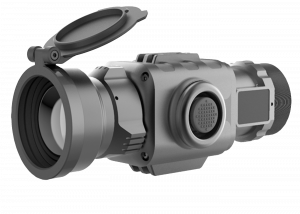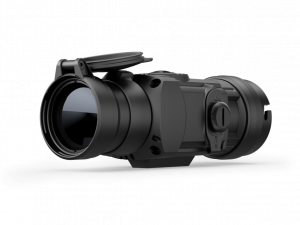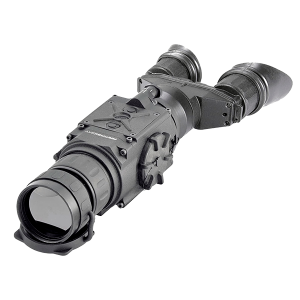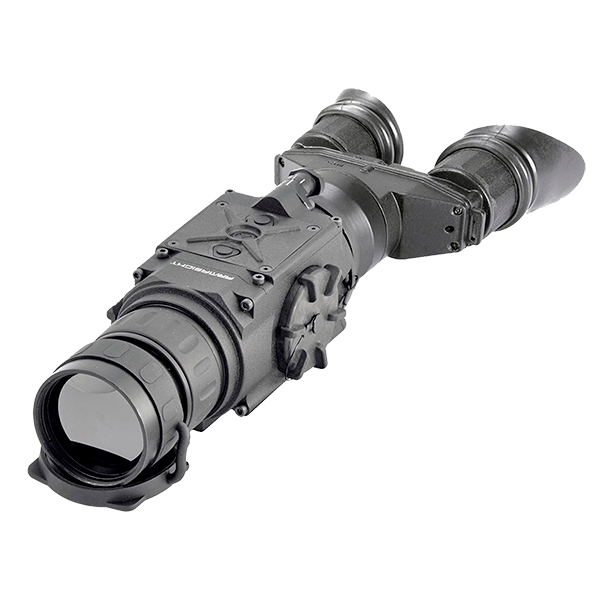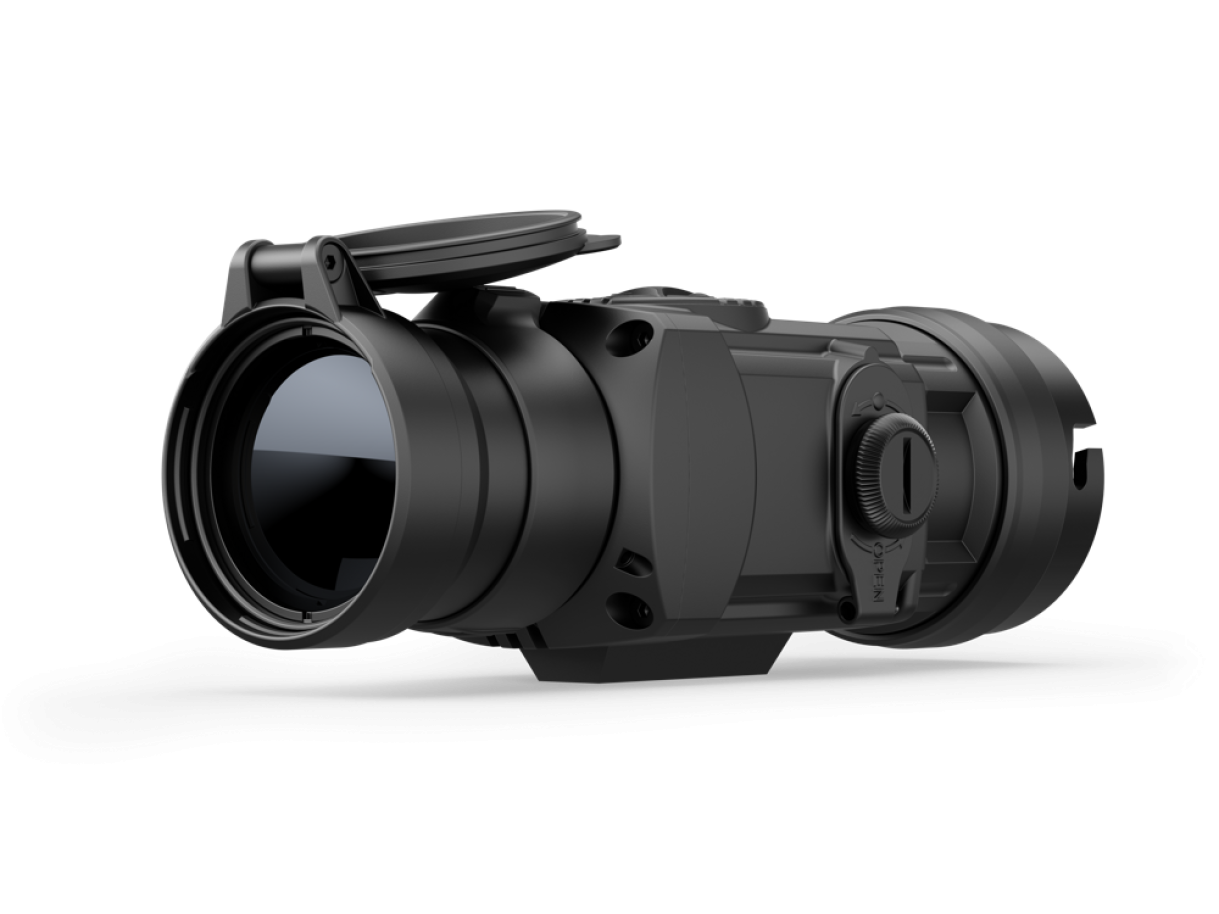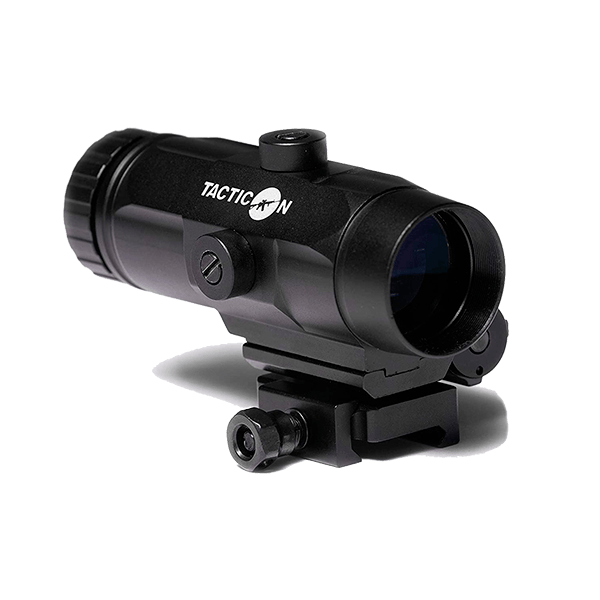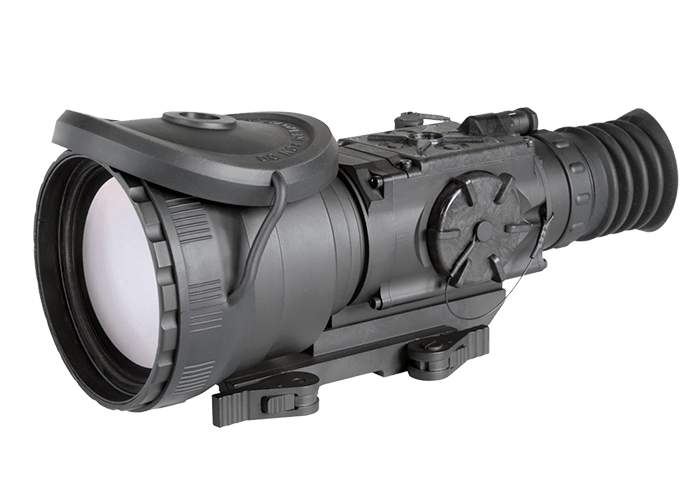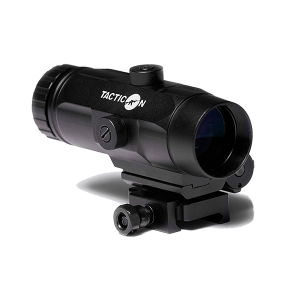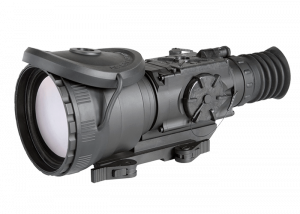
Humans do not have a well-developed ability to see in darkness, as have some other mammals. Some animals have evolved to the point that they have an exceptional ability to see in near-complete darkness, such as owls and cats. Our ability to see is enabled by light either emitted or reflected by an object.
In the darkness, there is very limited light, and our pupils are unable to recognize and use that light to see images. So, there are two approaches available to make objects visible in very dark conditions:
-
1)First is to use night vision technology, which amplifies what little lights are available (such as moonlight on a cloudy night) through goggles or night vision binoculars to make it visible to the human eye.
-
2)The second approach is to use a sensing system which will not use light, but instead, heat, to make images visible. This is called thermal imaging and is where we will focus attention on this article.
Comparison Table
We’ve selected five different clip on thermal imaging devices (which we will also refer to as scopes, just to save some words) from Amazon.com.
| Product | Best Features | Rating | Price Range | View on Amazon |
|---|---|---|---|---|
|
4.3 out of 5 |
|||
|
4.7 out of 5 |
|||
|
4.5 out of 5 |
|||
|
5.0 out of 5 |
|||
|
4.9 out of 5 |
How Thermal Imaging Works?
Thermal imaging devices can also be used in professional applications, such as preventive maintenance, looking for “hot spots” in motors, wiring, and so on. They are especially valuable to police and fire personnel involved in search and rescue operations. They can also be used for applications as mundane as looking for your dog in the back yard on a dark night.
In this article, we will be looking at a very specific product with a very specific use – clip-on thermal rifle scopes.
As with virtually all thermal imaging or night vision technologies, they started based on military needs. The earliest development of thermal imaging devices goes back to the 1920s, with a need driven by the inability of British air defenses to see incoming aircraft during World War I.
As we moved into the 1990s, the use of thermal imaging devices moved more into civilian markets. Technology changes and improvements made these devices affordable to the common market, and the applications noted above began to develop.
However, because of their military application potential, the export of many of these devices is strictly controlled. In fact, none of the five clip on thermal scopes we will be reviewing today can be exported.
If you have additional interest in how the technology works, please see the below video for a more detailed explanation:
Buying Guide
Before you dive into making a buying decision, it’s a good idea to make a quick review of available features and specifications on thermal imaging devices. The same specification may have wide variation from one scope to another; some specs will be standard on some units, optional on others.
The best way to decide what’s right for you is to review these features, and then tag each as either mandatory (won’t buy without it), nice to have (not really necessary but a good add-on), or bells and whistles (I’ll never use it). You then have an objective way to compare the scopes. Specifications will be drawn from Amazon and manufacturer’s web sites.
Before we begin this exercise, let’s just take a quick look at how a clip on thermal imager is used. Many of these units can be used as monocular imagers; hand-held thermal imaging capability. They are primarily used to clip on to a rifle, to be used in conjunction with the scope on the rifle.

Typically, that scope will provide the magnification capability, but some of these clip on scopes also have magnification. So, what these scopes will do is take the magnification capability of the standard scope, and convert it to thermal night vision. Here’s an example of a typical clip-on set-up:
The standard scope is toward the back of the rifle, and the thermal imagining scope is clipped on ahead of that scope to generate the thermal images. On to the buying guide.
Best Clip on Thermal Scopes Review
Armasight Command 336
A little bit pricy, but comes with a three-year warranty on the body and ten years on the electronics. It has an optional external power supply and video recorder. While the unit is fairly heavy at 1.5 pounds, it is durable, and operates in a range from -40oC to +50oC. It has digital zoom capability, and twelve available color palettes.
Pros
- Extensive operating temperature range.
- Highly variable color palettes for improved image display.
- Comes with light suppressors for day or night use.
Cons
- 30 HZ refresh rate
Pulsar Helion Thermal Monocular – Best Value
This unit falls in the middle of the pack as far as pricing, coming in at $4000. The lone rating on Amazon is 5.0 (scale of 1-5). It supports and external power pack, plus has USB capability for enhanced viewing or streaming. Suitable for both day and night use, it can also be used as a hand-held monocular, and easily clip to the rifle for shooting amplification.
Pulsar HeLION THERMAL MONOCULAR
Features and specifications:
- IPX 7 waterproof (submersible) even with the battery pack attached
- 384x288 pixels display capability, with detection range up to 1475 yards (human form)
- fairly light unit, at just under one pound without batteries
- requires 2xCR123A batteries, which provide about 4 hours operation. Power pack available separately
Pros
- Mid-range price as far as this group of clip on thermal scopes goes.
- Very fast 50 HZ image refresh rate.
- 2X digital zoom
- Operating range -25oC to +50oC
Cons
- Rifle clip not included, must be purchased separately.
- Does not have rangefinder capability.
Falcon V1 Thermal Imaging Scope
This is the low-cost unit of the five, at just over $2500. Only two reviews on the product, one 5 and one 1 to average 3.3. Day or night operation with a single AA or three CR123A batteries. Designed for short- to medium-range shooting, it has a wide FOV of 22o. 1X magnification but can be used with up to 6X during daylight operations.
Pros
- A “lower” priced unit probably geared to those with a first venture into advanced thermal detection scopes.
- Operating range -50oC to +50oC.
- One 5.0 rating but one 1.0 rating.
Cons
- Unable to find refresh rates on any web site.
- 1x38MM optics limits visual range and acuity.
PRG Defense Anaconda TC50 – Best Overall
High resolution lens, and a 1×50 optics package, and digital zoom of 2X and 4X. Lower priced than all but one of the group, but no customer ratings to date on Amazon. Changeable palette configurations, and up to five hours battery life with two CR123A. External battery pack (up to 44 hours operation) and video recorder available optionally.
Pros
- “Budget” priced item from this list of five clip on thermal scopes.
- Resolution and imagery are among the best of this group.
- 128MB on-board memory, expandable to 32GB.
Cons
- Weight is a little heavy.
- Unable to find any customer reviews on any web site.
Armasight by FLIR Zeus 640 – Best Performance
This is the big brother to the second item on our list, coming in with a hefty $7000 price tag. What that gets you, however, is a high-end resolution package, a crisp OLED display, and video output capabilities. It’s immersion tested at 20 meters for two hours, and operates from -40oC to +57oC. This is obviously produced with the professional hunter, military personnel, or SWAT personnel in mind.
Armasight by FLIR Zeus 640
Features and specifications:
- a little hefty at 1.6 pounds, but given the operating capabilities, not unreasonable
- 4 fixed and unlimited palette configurations for image clarity
- 1x50mm optics, 800x600 pixels display, 2X, 4X and 8X zoom capabilities
- environmental obscurants like smoke, dust, or fog do not affect operations
Pros
- It has all the bells and whistles, whether you need them or not.
- Digital compass and inclinometer built in to improve directional and shooting capabilities.
- 3/10-year warranty on tube/electronics.
Cons
- Price is restrictive for most commercial applications; this one is for the pros.
Conclusion
Just to get everything in one place, let’s take a look at our “best of” compilation, based on the price, ratings, features, specifications, and pros and cons of the reviewed clip on thermal imaging devices:
If you are considering the purchase of a thermal imaging scope anytime soon, hopefully, this will give you some tips on selecting the unit that’s exactly right for you and your application.

